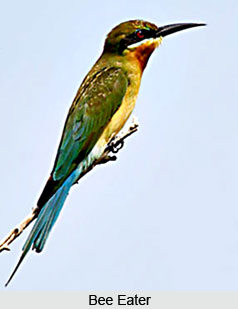 Bee Eaters are insectivorous birds of the Afro-Asian family, Meropidae, with a longish slender down curving black bill and pointed wings. Some species are migratory, others resident or local migrants. All the six species occurring in the subcontinent are chiefly a brilliant grass-green and vary in size between a sparrow and a dove. The commonest are the little Green Bea eater (Merops orientalis), the Chestnutheaded (M.leschenaulti) and the Blue tailed (M.philippinus). The largest, Blue bearded Bee eater (Nyctyornis athertoni), is a forest-dwelling species, less common and less social, keeping singly or in pairs. Bees and wasps taken on the wing in swift graceful sallies form their staple diet. Bee eaters love to perch on telegraph wires and bare branches, and they congregate in large numbers to roost communally in leafy trees. All species nest in self excavated tunnels in earth banks and roadside cuttings.
Bee Eaters are insectivorous birds of the Afro-Asian family, Meropidae, with a longish slender down curving black bill and pointed wings. Some species are migratory, others resident or local migrants. All the six species occurring in the subcontinent are chiefly a brilliant grass-green and vary in size between a sparrow and a dove. The commonest are the little Green Bea eater (Merops orientalis), the Chestnutheaded (M.leschenaulti) and the Blue tailed (M.philippinus). The largest, Blue bearded Bee eater (Nyctyornis athertoni), is a forest-dwelling species, less common and less social, keeping singly or in pairs. Bees and wasps taken on the wing in swift graceful sallies form their staple diet. Bee eaters love to perch on telegraph wires and bare branches, and they congregate in large numbers to roost communally in leafy trees. All species nest in self excavated tunnels in earth banks and roadside cuttings.
These birds are morphologically a simply uniform group. They have various similar features which relates them to Coraciiformes like rollers and kingfishers, having large heads (but smaller than their relatives) shorter neck, brightly feathered and shorter legs. The wings of the Bee eaters are pointed or round, with wing shape nearly related to migratory tendencies and foraging habitat. Small and round wings are possessed by species of Bee eaters which are sedentary and undertake shorter flights in reedbeds and denser forests. Those having long wings are much more migratory. They are highly aerial and take off powerfully from perches and fly at once without flapping, and are capable of changing directions very fast. However, the Bee eaters hover very rarely.
Bee eaters are seasonal monogamous and a few of the species remain monogamous for several seasons. The migratory species of Bee eaters are believed to make new pair bonds in each an every breeding time. The display of courtship in case of the Bee eaters are somewhat unspectacular, with exception of `butterfly display` (where both male and female bee eater`s wings are held out at the time of calling) of White-throated Bee-eater. A majority of the members of the family make them busy in courtship feeding, by the male offering a prey item to the female counterpart, and this type of feeding can be much if not all the energy the females Bee eaters need for their egg creation. They might nest as single pairs or in dense colonies or loose colonies. Some of the smaller species of Bee eaters have the tendency to form their nest solitarily, whereas the medium sized ones do form their nests in the smaller colonies and the migratory and larger species of Bee eaters nest in bigger colonies which numbers even in thousands. In some cases the colonies of these birds may bear more than a single species.
The species of Bee eaters are pretty catholic in their habitat and they need just an elevated perch from where they can watch the prey and also a ground substrate where their breeding burrow can be digged. Since the prey of the Bee eaters are fully caught on wings, they thus do not rely on any vegetation type. These birds are diurnal (i.e. they are active during the daytime) however some of the species also migrate at night in case the terrain on route is in suitable for stopping or while the Bee eaters are crossing the sea. The Bee eaters are highly social and the pairs of these species can be seen sitting so close that they are touching each other. They are exclusive air hunters of insect prey. They catch the prey either while in flight or from an open perch where they sit and look out for the prey.











